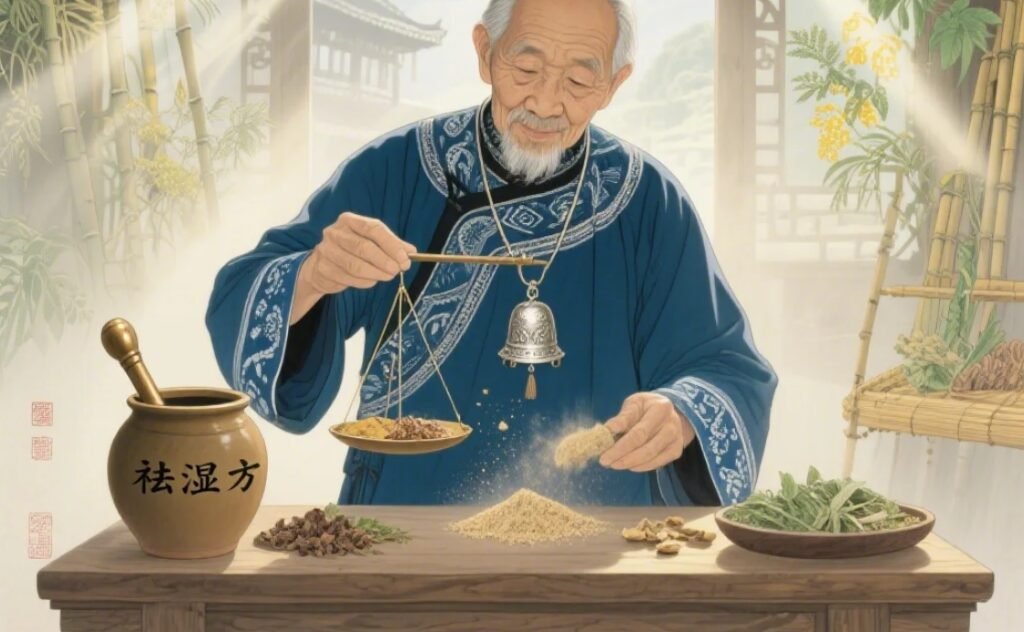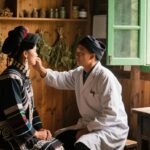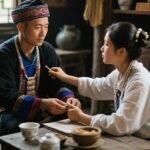Suxiang (Reversed Stomach)
[Overview]
In Miao medicine, reversed stomach is referred to as suxiang. Suxiang is a condition in which food enters the stomach but the residual grains are not digested, leading to distension of the upper abdomen. More than four hours after eating, digestion does not occur, and undigested food is regurgitated from the stomach.
In Traditional Chinese Medicine (TCM), reversed stomach refers to a syndrome characterized by postprandial epigastric distension, failure to digest food, and vomiting of undigested food from a previous meal, such as vomiting in the evening what was eaten in the morning, or vomiting in the morning what was eaten the night before.
In Western medicine, conditions such as simple diaphragmatic spasm, gastrointestinal neurosis, gastritis, gastric dilation, and diaphragmatic spasm following abdominal surgery may be treated with reference to this condition.
[Huhoujipeng · Symptoms in Miao Medicine]
Suxiang is considered a minor condition in Miao medicine, and it is divided into two types: heat-channel suxiang and cold-channel suxiang.
[Aijiangduo · Etiology]
Miao medicine attributes this illness to irregular diet, overconsumption of alcohol and meat, excessive worry, immoderate sexual activity, and invasion by pathogenic toxins, all of which damage the “dujia” (abdominal support system). This results in impaired transportation and transformation by the spleen and stomach, a weakened digestive system, food retention, and reverse flow leading to illness.
[Gengduomeng · Pathogenesis]
The condition is caused by multiple factors leading to gastrointestinal weakness and impaired digestion, resulting in the inability to process food and subsequent reverse flow. Grains nourish the body, but improper eating habits, consumption of unclean or raw and cold food, excessive meat, alcohol, or spicy foods, combined with emotional stress and fatigue, all damage the qi and blood of the gastrointestinal system. This weakens stomach qi and digestive transformation, causing food to accumulate in the stomach. When stomach qi rebels, food is ejected upward, resulting in the disease.

[Diagnostic Key Points]
Diagnostic Criteria
Main manifestations include epigastric distension, vomiting of undigested food long after eating, vomiting in the evening after a morning meal, or vice versa.
Relevant Examinations
Gastrointestinal barium enema imaging and endoscopy may assist in diagnosis.
[Differential Diagnosis]
Ailuo’e (Vomiting)
Both suxiang and ailuo’e involve vomiting after eating. However, ailuo’e is mostly caused by disruptive pathogenic qi and disharmony of the stomach, characterized by immediate vomiting after eating, vomiting without food intake, or irregular vomiting patterns, usually ejecting food eaten that same day.
Suxiang, on the other hand, is often due to internal pathogenic invasion, damaging spleen and stomach function and weakening digestion, leading to food retention and reverse flow. It is typically marked by the ability to ingest food, but regurgitation occurs long afterward, vomiting the previous meal (e.g., morning food at night, or vice versa).
[Bing’ai Dunbun Fanlao Shefen Liu Doujiu Fulai Wawa Jiuke Kewu Lifen Tiao Jian Linghu Gufu Fang Sasa Luu Tan Zhi]
Cold-Channel Suxiang
Menglidu (Clinical Manifestation): Vomiting of undigested food or clear water more than 4 hours after eating. Symptoms improve and become more comfortable after vomiting. Other signs include pale complexion, fatigue, cold limbs, dizziness, tinnitus, and infrequent loose stools.
Xingleng (Channel Type): Cold-channel cold-type illness.
Jiahemeng (Treatment Principle): Xiyi yangjiegugu (eliminate food retention and accumulation), heqizhanshe (warm the stomach and dispel cold), maijing maiweichaoqi (tonify the spleen and reinforce the center).
Ouduoxijia, Gang’ou (Prescription and Explanation):
Mujiangzi (Tetradium ruticarpum), 10g
Lulutong (Liquidambar orientalis), 15g
Magnolia bark, hou po, 10g
Fang feng (Saposhnikovia divaricata), 15g
Polygala tenuifolia, xiao yuan zhi, 10g
Bamboo shavings, zhu ru, 12g
Decoction taken orally.
Herb Functions:
Mujiangzi (Tetradium ruticarpum), hot in nature, acrid and slightly spicy in taste, enters cold channels; warms the stomach, promotes qi flow, relieves pain, removes dampness, and strengthens digestion.
Lulutong (Liquidambar orientalis), cold in nature, bitter taste, enters heat channels; expels wind and cold, regulates qi and meridians, relieves pain and dissipates stagnation.
Magnolia bark, hou po, cold and bitter with a slightly spicy taste, enters heat channels; regulates qi, dries dampness, eliminates accumulation and distension, promotes downward flow.
Fang feng (Saposhnikovia divaricata), cold, pungent and spicy, enters heat channels; warms the middle, dispels cold, moves qi, relieves pain, eliminates wind, and detoxifies.
Polygala tenuifolia, cold and bitter-spicy, enters heat channels; calms the mind.
Bamboo shavings, zhu ru, cold and bitter, enters heat channels; descends qi and stops vomiting.
Heat-Channel Suxiang
Menglidu (Clinical Manifestation): Frequent distending pain in the upper abdomen, vexation and heat, thirst, worsened after meals, dizziness, heart discomfort, vomiting of white frothy fluid, regurgitation of undigested food or clear water, possibly vomiting of blood or brown fluid, and in severe cases, hematochezia.
Xingleng (Channel Type): Heat-channel heat-type illness.
Jiahemeng (Treatment Principle): Xiyi jieting (eliminate food retention), tisouqi (regulate qi and harmonize the stomach), dangwang (nourish the heart and calm the spirit).
Ouduoxijia, Gang’ou (Prescription and Explanation):
Tu bie chong (Eupolyphaga sinensis), 12g
Glutinous rice ball, nuo mi tuan, 20g
Codonopsis pilosula, dang shen, 20g
Dioscorea opposita, shan yao, 20g
Decoction taken orally.
Herb Functions:
Tu bie chong (Eupolyphaga sinensis), hot and salty, slightly toxic, enters cold channels; invigorates blood, removes stasis, unblocks meridians, relieves pain.
Glutinous rice ball, nuo mi tuan, neutral and bland; strengthens the spleen, promotes digestion, clears heat, removes dampness, tonifies deficiency.
Codonopsis pilosula, dang shen, warm and sweet, enters cold channels; tonifies the middle, boosts qi, strengthens the spleen and lungs, nourishes blood and fluids.
Dioscorea opposita, shan yao, warm and sweet, enters cold channels; strengthens the spleen, nourishes the stomach, clears heat, detoxifies, regulates qi, and relieves pain.
[Prevention and Care]
Improve dietary habits, quit smoking and alcohol, avoid moldy food, and enhance nutrition by eating more fresh fruits and vegetables.
Treat chronic esophageal and gastrointestinal diseases promptly.
During (used in traditional contexts), advise patients to drink a small amount of warm water after each meal to help dilute food and mucus in the esophagus.
Maintain a cheerful mood and engage in moderate physical activity.
[Remarks]
Miao medicine holds that besides external causes, internal pathological changes involving qi, blood, and fluids are the root of disease. Injury to qi also harms fluids; damage to fluids affects qi. Qi drives blood; blood carries qi. Qi, blood, and fluids are interrelated and interdependent.
This condition results from improper diet, excessive worry, or sexual exhaustion, which damages the spleen and kidney, leading to deficiency-cold of the spleen and stomach. This impairs the transformation of water and grains, causing food retention in the stomach and reverse flow. Furthermore, vomiting injures qi, fluids, and blood. Treatment focuses on warming and tonifying the spleen and kidneys, supplemented by replenishing qi and blood.


Leave a Reply